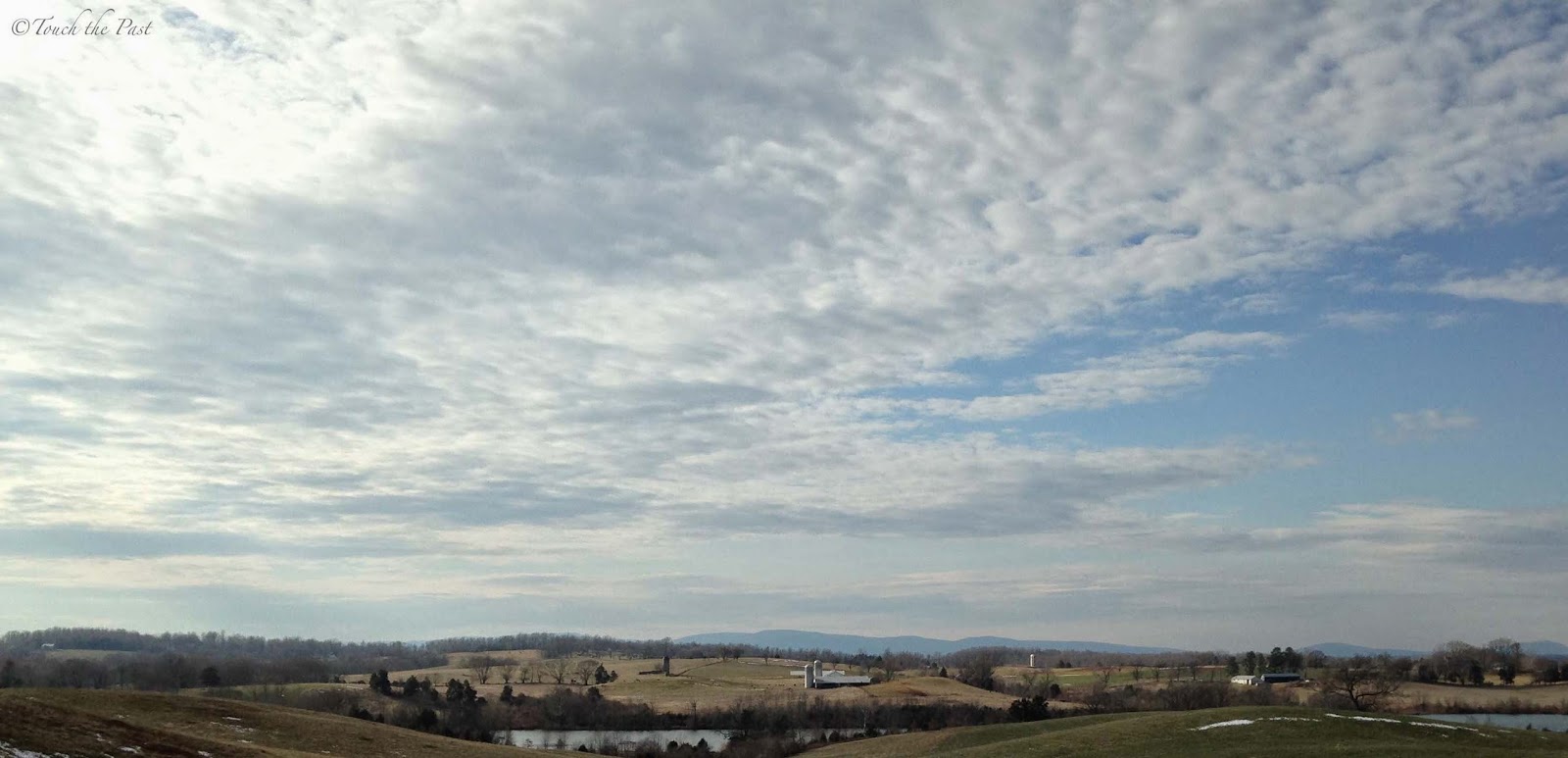 |
| A glorious view from DIV 27 |
Ten Years of DIV
Diggin' In Virginia numbers 26 and 27 were back-to-back hunts held respectively at the Spillman and Brandy Rock farms in Culpeper, VA from March 24th to the 29th. DIV 27 at Brandy Rock actually marked the tenth anniversary of Digging in Virginia which is testament to the hard work of the DIV staff and volunteers as well the vision and dedication of John and Rose Kendrick. That vision has not only stood the test of time but has been increasingly popular, with new attendees every year. Ultimately, DIV has made it possible for hundreds of people from around the country to discover and preserve tens of thousands of relics from the Civil War which would otherwise be lost to time.
 |
| The Tenth Anniversary DIV Photo by Rick Martin |
When I first read about DIV five years ago, I had just moved back to North Carolina after over a decade of living and working in Silicon Valley. I was excited to be back in my native state where there was so much history and I started reading everything I could about the Civil War to see if I could locate some Civil War sites in NC. It was during the course of that research when I first read about DIV. The idea of being able to walk on the very ground where all those acts of heroism and valor occurred seemed too good to be true, to say nothing of being able to find and keep relics. Even after attending DIV for several years, I still feel giddy for having the privilege to visit and detect these incredible sites.
Before discussing DIV 26 and 27, I want to thank John and Rose Kendrick for allowing so many of us to personally experience the history of the Civil War. DIV has given me a profound appreciation for what our forebears lived through and fought for and has deeply affected my perspective not only on the Civil War, but on my own life, our government, our educational system, and the future of our country. It's also a heck of a lot of fun. So thank you, John and Rose—I hope DIV thrives for another decade!
Background
Last year, thanks to an insanely busy schedule, I was unable to attend DIV. I had located two large Civil War campsites in the Raleigh area and I didn't even have enough time to regularly detect those. So, with the prospects for attending DIV looking grim, I sold my GPX 4800 and resigned myself to only hunting my local camps.
But when DIV 26 and 27 were announced, I realized that my schedule might actually enable me to go back to Culpeper this year. There was an industry conference the week before which I had to attend but in spite of that my incredibly gracious wife encouraged me to go to DIV and volunteered to watch our young children for two weeks in a row in addition to working. So I put my name in the hat for DIV and was fortunate enough to be invited to both. My next stop was to give Don Dodson from
North Georgia Detectors a call and order a new GPX 4800.
There is just nothing like Virginia when it comes to Civil War history. The farms on which DIV is held have long histories that date back to the 18th century (or older) and appear much as they did during the War. The relics that lie beneath their characteristic red clay soil span the entire duration of the war and thus the spectrum of artifacts is highly varied. You may find everything from .69 caliber minié balls from the beginning of the conflict to Type III Williams bullets from its last days. You literally never know what will emerge when you put your shovel into the ground. And that is the appeal of relic hunting in Culpeper.
As Rose is fond of saying at the customary DIV pre-hunt meeting, they can't guarantee good weather or that you'll find relics but they do guarantee that you'll have a good time and leave Culpeper with new friendships. DIV 26 and 27 certainly proved her right, once again.
DIV 26
This was the third DIV held at the Spillman farm and my
second time to the site. Weather on this first day was absolutely ideal and as I strode out into the rolling hills of Spillman, I was exhilarated to be back and to see what relics remained.
 |
| A view of Spillman on day 1 of DIV 26 |
As on my previous hunt, I recovered some Confederate bullets including a nice dropped Gardner, a dropped Ringtail sharps, a fired sharps, and from Federal positions, some standard .58 minié balls.
 |
| Bullets from day 1 of DIV 26 |
 |
| Closeup of fired and dropped ringtail sharps |
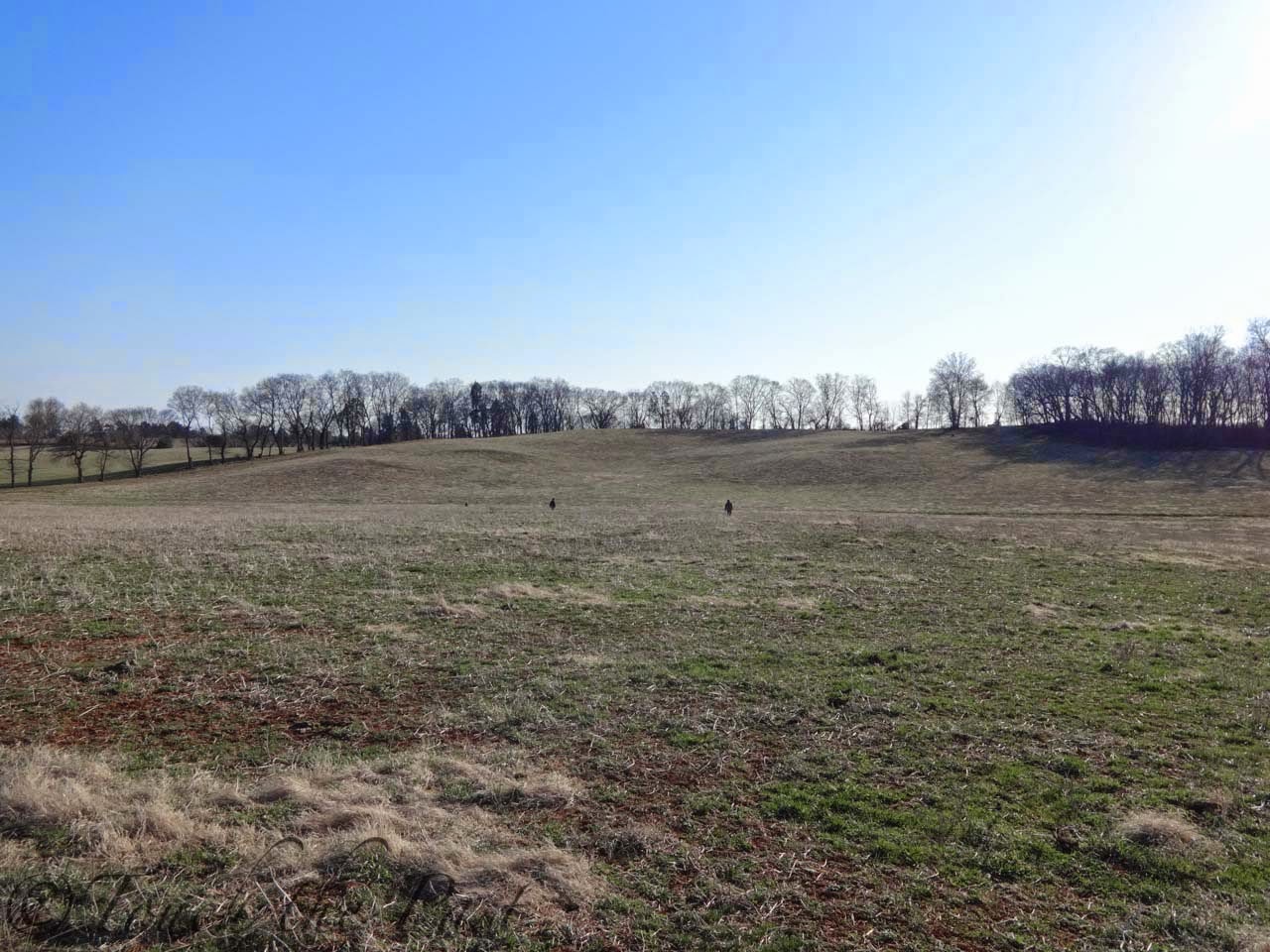 |
| General vicinity in which CSA bullets were recovered |
Unlike the previous hunts however, it seemed there were no obvious, dense concentrations of relics. But by hunting slowly and focusing on faint signals, it became apparent that lots of artifacts yet remained to be discovered.
Day 2 at Spillman and I awoke early in the morning to anxiously check the weather. Forecasts had predicted snow which seemed surreal given the Spring like conditions the day before. And yet the meteorologists, on this occasion, were absolutely right. Shortly after arriving at the farm, the gray skies proceeded to disgorge an absolutely stunning amount of snow which, in a matter of minutes, began to obscure the green fields under a blanket of white. Undeterred, stalwart detectorists, wearing overalls, parkas and hoods and with their expensive pulse induction machines wrapped in protective plastic, strode out into the fields. The forecast called for accumulation of 1 to 3" by afternoon at which time the snowfall was predicted to end.
 |
| Look closely, those aren't cross country skiers ... |
This time however, the meteorologists got it wrong. As it turned out, it snowed nonstop from 7:10AM until 7:30PM. Total accumulation was about 5 to 6", maybe more. After doing our best in these conditions my fellow riders and I all threw in the towel at about 12:45 PM and headed back to the hotel to thaw out. Even though my feet were actually dry and warm, after digging a few holes my gloves were soaked and my hands were turning into popsicles.
 |
| Me looking amused by the lack of sensation in my hands |
Finally, by evening the snow stopped. When we woke up the following day, the fields of the Spillman farm had been transformed.
In my previous blog entry about Spillman (click
here to read it) I mentioned the incredible amount of relics found around an old oak tree. Seeing that ancient tree a year later as it towered alone over the snow covered fields reminded me of one of my favorite lines from Homer:
As is the generation of leaves, so is that of humanity. The wind scatters the leaves on the ground, but the live timber burgeons with leaves again in the season of Spring returning. So one generation of men will grow while another dies.
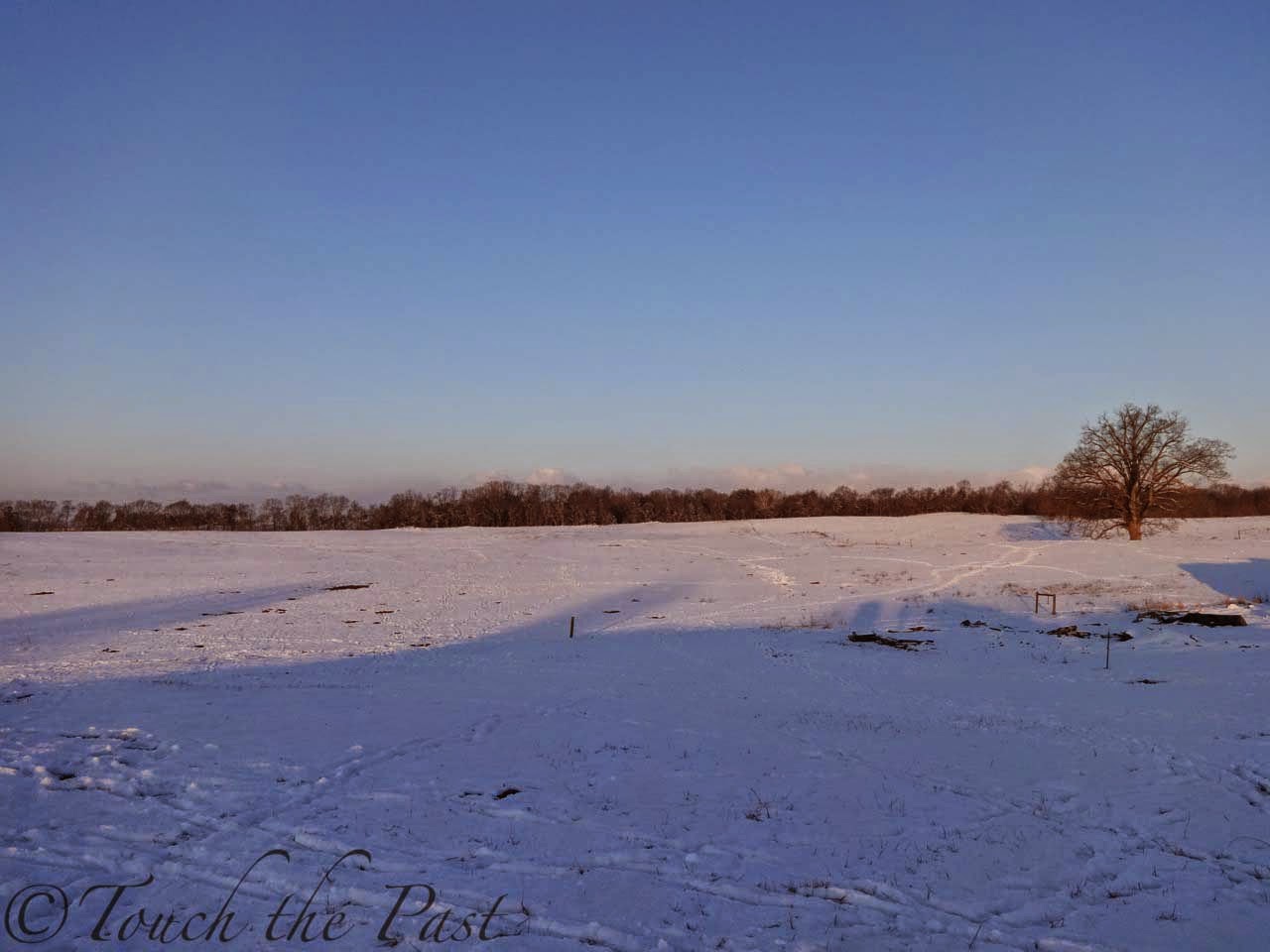 |
| The Ancient Oak at Spillman |
Hunting in these wintry conditions was, suffice to say, difficult. With snow depths of up to 7" in places it significantly hampered the depth at which even the best detector could hear relics.
 |
| Third day conditions at Spillman. Note the dig holes. |
It was on this day that I began to experience what ultimately turned out to be a personal record for equipment difficulties and "disasters." The first thing to fail was the 11" DD coil on my Minelab GPX 4800.
Shortly after I snapped the above photo, my detector began to emit periodic and extremely loud sounds. At first I wondered if it might be EMI but the sounds were completely random and, together with the deep snow, made detecting exceedingly difficult. Finally, I turned my machine off and on and the coil became totally unresponsive. Waving my shovel under it, something that would normally "blow your ears off," did nothing. Unfortunately, my other coil was back at the hotel so my detecting for the day was done. Thankfully, it was already fairly late so I didn't miss too much of the day.
That evening, I sent an email to Don Dodson who was attending DIV and told him about my coil issues. His reply came minutes later: He'd replace my coil (which was still under warranty) the very next morning. Talk about great customer support! So, thanks to Don, I was back in the saddle with my stock coil the very next morning, the first day of the hunt at Brandy Rock. I'd like to once again extend huge, huge thanks to Don for his support. And, as I've previously said here, if you're in the market for a metal detector, you owe it to yourself to call
North Georgia Detectors.
DIV 27
DIV 27 saw the return to Brandy Rock, a massive property that was home to the 6th US Army Corps during the winter of 1864. Many an amazing relic had come from Brandy Rock on preceding DIVs. And, with the weather clearing, anticipation was high the morning of March 27, even if the temperatures were low.
And by low I mean 18 degrees Fahrenheit with up to 30mph winds. I know that may not sound like much to some, but growing up in southern North Carolina left me with little tolerance for temperatures south of 50 degrees. As we all lined up for the 10th anniversary DIV group photo, I was glad to be surrounded by so many bodies that provided at least some protection from the wind.
 |
| Dawn at Brandy Rock |
Earlier that morning, as I was loading my gear into Vaughn's truck, the second of my gear mishaps occurred. I had put my prescription sunglasses, my preferred detecting eye ware, into my shirt pocket. I leaned against the truck to place my detector inside and heard a loud "snap." And that was that for a wonderful pair of glasses that had enabled me to see since my honeymoon over 6 years ago. I had packed a spare pair of glasses however so all was not lost. Yet ...
I had never before been to Brandy Rock. Josh and Vaughn however had, and they recommended we start at a place where they'd had good luck the last time they were there. We hiked over some very steep terrain, down one hill, up another, to our destination: An interesting location at the top of a hill.
It resembled a natural amphitheater with a small puddle at its lowest point. There was a good view of the surrounding hills from the edges of the "bowl" and its advantages as a defensible, comfortable camp were apparent.
 |
| The "Amphitheater" |
Practically no one else was here. So we turned on our detectors and got to work. And at this point an interesting coincidence occurred.
I put my coil down and literally on the first sweep heard an unmistakably good signal —quite loud and definitely non-ferrous. I dug a circular plug and, deeper than expected given the strength of the signal, recovered an Indian head penny dropped by a soldier on this very spot.
The interesting coincidence was that my very first find at DIV 23 at Spillman had been an Indian Head penny. Recovering a coin is always a nice way to start the hunt.
And then the third in the ongoing saga of my equipment mishaps occurred. As I was replacing the plug in the hole I'd just dug, a lens from my backup glasses fell out of the frame and onto the ground. I picked it up and tried to snap it back into place but nothing would convince that lens to remain in the frame again. Not wanting to waste more time, and with the relatively small area suddenly congested with other detectorists, I reluctantly took off my glasses, resigned to do without distance vision (I'm woefully near-sighted).
My next find was a piece of "soldier art" —a .58 minié ball that had been flattened and then cut in half from top to base.
 |
| Flattened and bisected minié compared to normal projectile |
Whenever I find one of these flattened bullets, the first thing that comes to mind is, "How did they do that, and why?" All we'll ever know is that a soldier back in 1863 turned a cartridge in his pouch into something for some particular purpose lost to time or simply out of boredom.
Eventually, the "Amphitheatre" became jam packed. The quaver of other machines made it hard to pick out the interesting signals and dig holes were everywhere. But moving slowly and carefully paid off and before departing the area I pocketed a few buttons including an Eagle I with a beautiful green patina.
 |
| General service and Eagle I buttons recovered from Brandy Rock |
On Day 2, I moved to the center of the Brandy Rock property and saw, for the first time, the Wellford Plantation home, often referred to as "Farley."
 |
| The home of Dr. William Wellford, aka "Farley" |
This incredible structure has witnessed so much history. Farley served as Jeb Stuart's headquarters in 1862. In June of 1863, the grounds around the house comprised part of the battlefield on which the Battle of Brandy Station was fought. Wounded and dying soldiers sought shelter within Farley.
The following year, General John Sedgwick of the Union 6th Army Corps made Farley his headquarters for almost six months.
 |
| General Sedgewick (third from right) and staff officers at Farley, March 1864 |
Sedgewick is famous (or infamous) for the circumstances of his death at the Battle of Spotsylvania Court House on May 9, 1864. He had moved to the front in order to personally supervise disposition of infantry troops under his command. From a distance, Confederate sharpshooters were taking shots at the soldiers who instinctively ducked and sought cover. Sedgewick scolded them, "What!? Men dodging this way for single bullets? What will you do when they open fire along the whole line? Why are you dodging like this? They couldn't hit an
elephant at this dist ..."
Before he could complete the last word, he himself was struck and killed by a minié ball which hit him just below the left eye. This occurred two months after his stay at Farley.
 |
| The entrance road to Farley |
In the fields west of Farley, I found a few spots containing relics that had thus far eluded detection. My finds weren't spectacular but, after more than a year without using a pulse induction machine, I was beginning to re-learn the GPX 4800, understand its complex spectrum of audio signals, and make deeper and better recoveries.
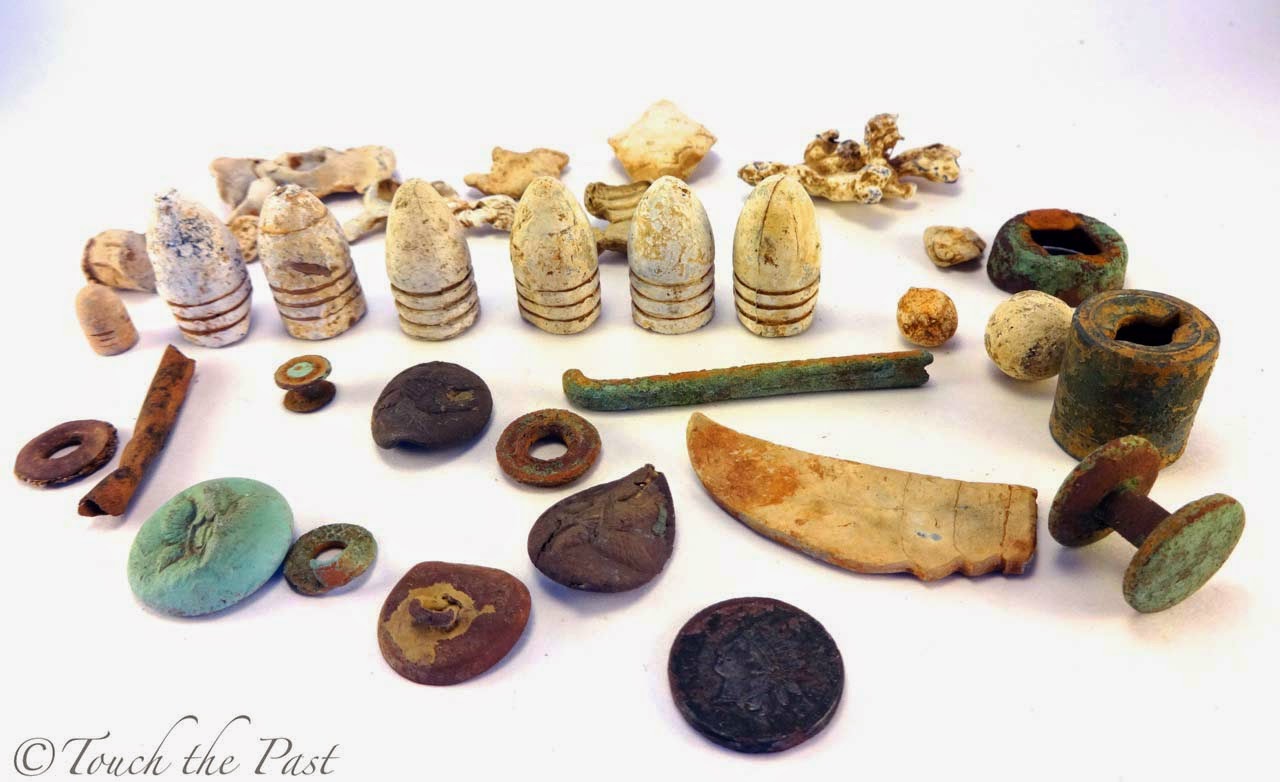 |
| Brandy Rock Artifacts |
 |
| Always a thrilling sight |
Day 3 of DIV 27, the last day, dawned and, in spite of grim weather forecasts, there was only a periodic sprinkling of rain. We considered ourselves fortunate but double checked the plastic bags protecting our machines once more.
And now we come to the final chapter in my chain of disasters. Lifting my shovel with one hand, I brought it down with force and instead of it sinking into the soft, red clay, it struck a rock. And although I've dug a lot of holes, the impact of shovel on stone was unlike anything I'd ever experienced. Over the course of the next hour, it became increasingly difficult to move my wrist and, when I did, there was an awful creaking sensation in my arm like a door on a rusty hinge. I invited some friends to touch my arm while I moved it and I have to admit it was highly entertaining to see them cringe.
As I was to learn two days after DIV during a visit to Urgent Care, I had actually ruptured a tendon. The moral of the story is to not push your shovel into the ground while your arm is perpendicular to the shaft. Let your body weight or a push with your foot do the digging. Ironically, my friend Josh had given me this very advice prior to DIV.
 |
| See that hump on the top of my arm? That's not supposed to be there. |
Shortly after I messed up my tendon, I broke something else: My shovel. I'd been using a long handled trenching shovel of the kind recommended by Beau "Aquachigger" Ouimette primarily to avoid having to get down on my knees on the wet ground. But the amount of water in the soil made plugs heavier than usual and the weight of wet red dirt proved too much for its fiberglass handle --without warning, it simply snapped.
 |
| One of these things is not like the others |
Thankfully, Vaughn had parked the truck close by and I had my beloved
Predator Tools Big Red shovel in the back. Suffice to say, I'll probably never use anything but a Predator Tools digger again. They truly are the best.
I dug a few round balls, a sword belt rivet, and a few other odds and ends before it was noon and time to attend the BBQ. We packed up our machines, got in the truck, and drove past Farley to a covered, open air structure that was perfectly suited for lunch and relic displays.
As I was standing in line, I saw Rose, said "Hello" and introduced myself. She looked at me, grabbed my arm and, pulling me out of line, said simply, "Come over here." She took me a few steps away to John Kendrick and said, "John, this is Jim Black." John gave me a look and said, "I love your blog." I was completely unprepared for that coming from John and it absolutely humbled me and absolutely made my day.
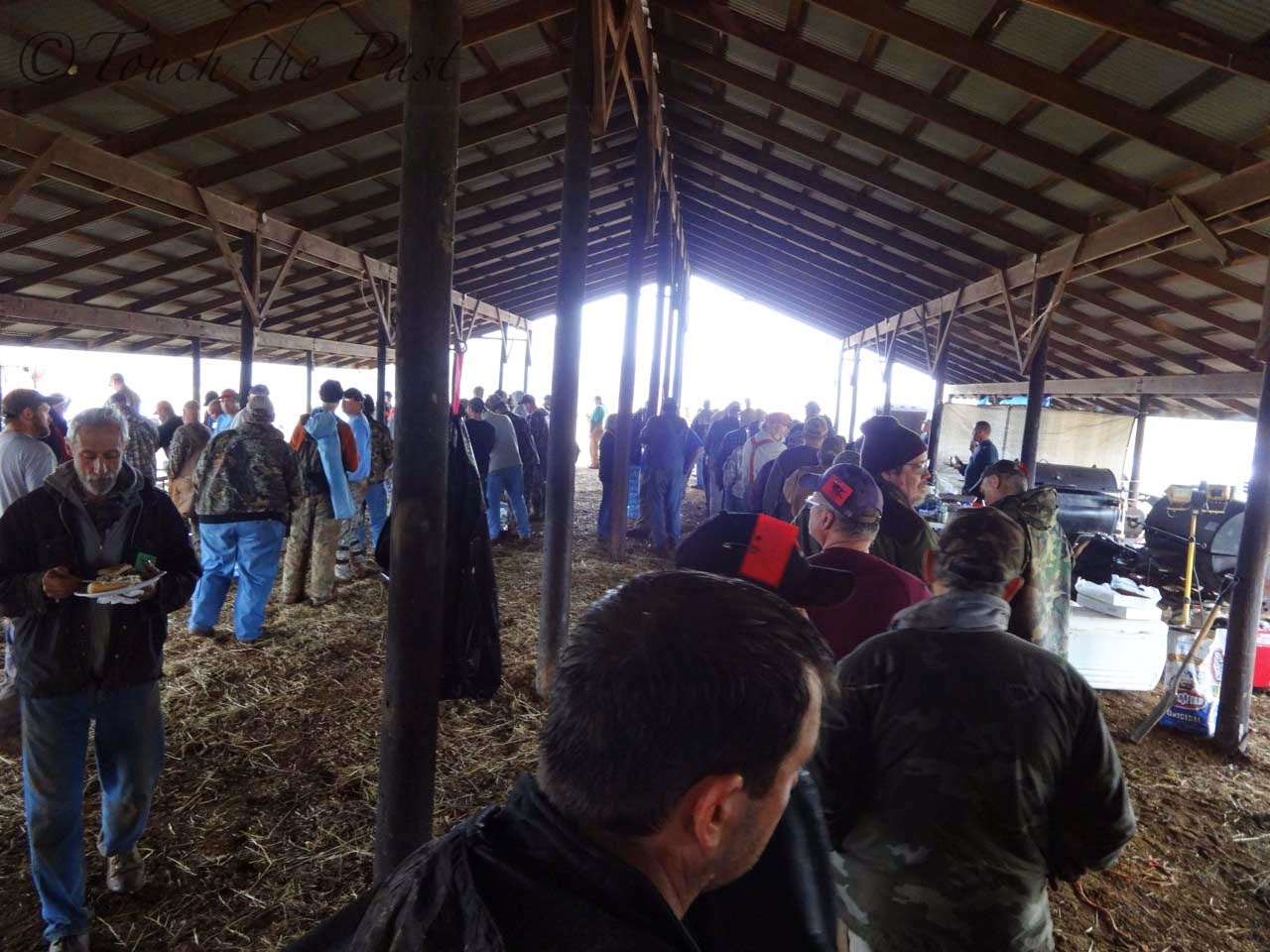 |
| The line for BBQ |
 |
| The view while we ate |
 |
| Josh and Vaughn, my excellent hunting partners |
Final Hours
After lunch, Vaughn, Josh, and I went to the firing range. At DIV, this is apparently termed the "walk of shame" as all you will dig on the firing range are, of course, fired bullets. But after 5 days of hunting in some pretty extreme weather, we were bushed. The idea of digging just for fun seemed appealing and indeed, it was an absolute blast (no pun intended).
The firing range was a steep hill, now covered with trees, with a beautiful, green river at its base. As we hiked through the woods and approached the range, a large buck jumped into the river and swam to the opposite bank. It was completely silent but for the sound of the rain on tree leaves.
Climbing up the slippery hill was more difficult than you might imagine, especially with a ruptured tendon. But literally every signal was a bullet from the Civil War, untouched since 1863 or 1864. I uncovered one that was flattened on one side from striking a rock. And, sure enough, in the hole was a large rock, undoubtedly the very one it had hit 150 years ago when the place I was standing was a completely different world.
 |
| Bullets from the firing range including a fired Type II Williams Bullet |
Conclusion
This was not my most productive DIV by a longshot. I didn't find anything miraculous nor was the quantity of my finds up to par. But paradoxically, it was one of if not the most enjoyable DIV I've yet experienced.
Once I was back in Durham, I had to drop off one of our dogs at a kennel for the day. A few thousand yards away from the kennel, tucked away amid office parks, fast food restaurants, and the thrum of 21st century street traffic, is this.
 |
| The Bennett House in Durham, NC |
This is the Bennett House or "Bennett Place" in Durham, the humble home where General Joseph E. Johnston surrendered 80,000 Confederate troops to Union General William T. Sherman. I stopped the car and got out to look at it and reflect on the past week's experiences.
The home itself has been reconstructed after being destroyed by fire in 1921 only the chimney is original. A few things struck me. First, was the absolutely vast scale of the Civil War. Here I was, 4 hours away by car from Culpeper, and yet the War had been here, too. Regiments that played a key role at the Battle of Brandy Station including the Jeff Davis and Cobb Legions had fought here, too.
The Civil War, even as it's enjoyed renewed attention during its 150th anniversary, has become something of a historical pariah, especially in the South. Perhaps that's due to the way that popular media and pundits have portrayed the war as one stemming from racism. As a result, most people are uncomfortable even talking about it.
That is a shame. It's a shame because attempts to politicize or distort the historical record ensure that we don't learn the actual lessons. Over 620,000 Americans, North and South, lost their lives during the Civil War. Countless other lives were forever diverted. And the reverberations of this conflict affect us to this day. As Shelby Foote so perfectly expressed it:
"Any understanding of this nation has to be based, and I mean really based, on an understanding of the Civil War. I believe that firmly. It defined us. The Revolution did what it did. Our involvement in European wars, beginning with the First World War, did what it did. But the Civil War defined us as what we are and it opened us to being what we became, good and bad things. And it is very necessary, if you are going to understand the American character in the twentieth century, to learn about this enormous catastrophe of the mid-nineteenth century. It was the crossroads of our being, and it was a hell of a crossroads."
There is an ongoing debate between self-styled "relic hunters" and archaeologists. The latter insist that relic hunters destroy the provenance of relics and are only interested in the objects themselves, not the history, and as a result much data is lost. The former point to archaeologists as proponents of restrictive legislation that deprives amateur historians of the right to pursue their interests.
The fact is, amateur historians, relic hunters, and archaeologists are all in the minority today in that we are the ones who care about history and who want to preserve it. All three communities need to work more closely
together and learn from each other to ensure that the precious, finite vestiges of our past, are preserved for future generations.
 |
| Monument to Unity at Bennett Place |
Thanks
Thanks once more to the DIV staff and volunteers, and especially John and Rose. Thanks to Josh for transportation to and from Culpeper, and to Josh and Vaughn for rides to and from the hunts, for excellent companionship, and for introducing me to culinary experiences undreamed of in Culpeper. Huge appreciation to Don Dodson of North Georgia Detectors for replacing my dead coil at the speed of light. And thanks especially to my wife and family for allowing me to spend two weeks back-to-back away from home.
DIV 26 and 27 Finds Gallery
Note: These are the relics found by DIV attendees and displayed during the Saturday BBQ. These aren't my finds (I wish!).




























































